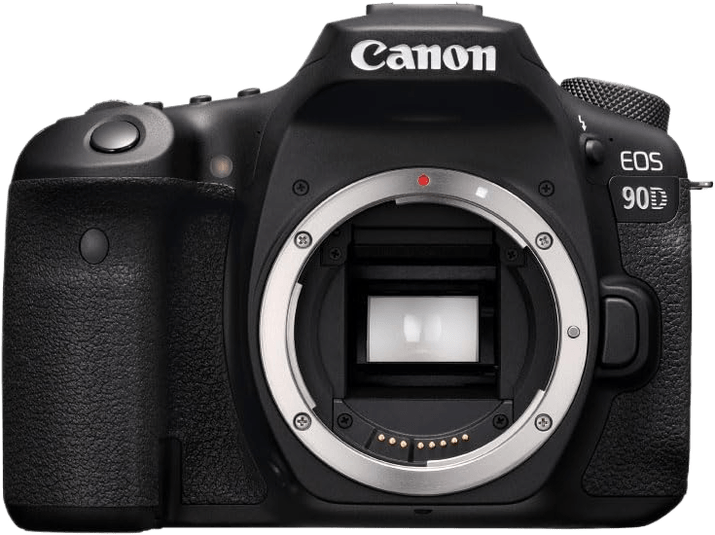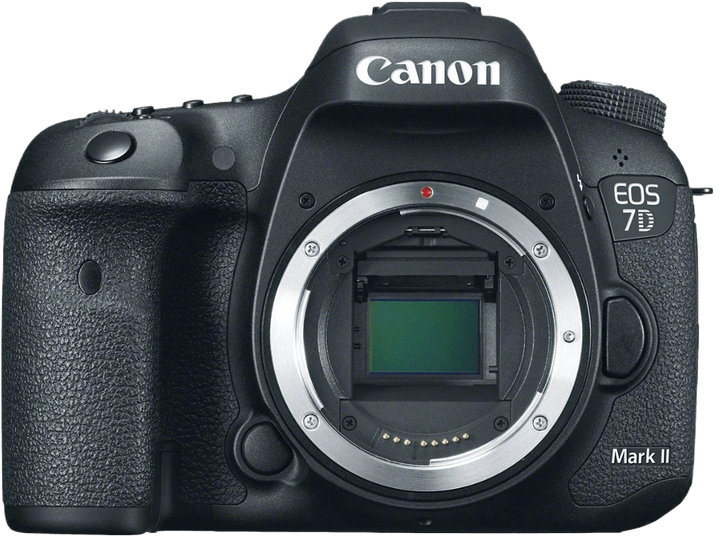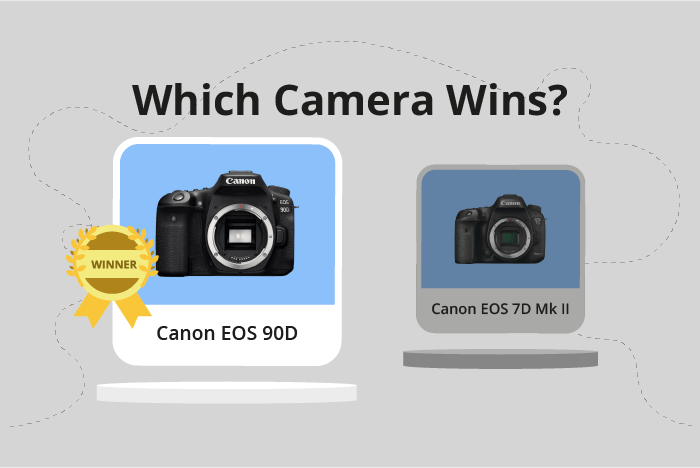Canon EOS 90D vs EOS 7D Mark II Comparison
Canon EOS 90D

Canon EOS 7D Mark II

The Canon EOS 90D outperforms the Canon EOS 7D Mark II with a score of 67/100 compared to 60/100. Both cameras share common features as DSLRs, with the 90D announced in 2019 and the 7D Mark II in 2014. The 90D has the advantage of being lighter, weighing 701g, and more compact at 141 x 105 x 77mm. Additionally, it has a lower launch price of $1199 compared to the 7D Mark II’s $1800.
The 7D Mark II, however, is a bit larger at 149 x 112 x 78mm and heavier at 910g. It may not have significant advantages over the 90D, but its solid construction and performance still make it a viable option for photographers. Ultimately, the Canon EOS 90D offers better value and improved features, making it the superior choice between the two models.
Canon EOS 90D vs EOS 7D Mark II Overview and Optics
The Canon EOS 90D narrowly edges out the Canon EOS 7D Mark II in optics, scoring 62/100 compared to the 7D Mark II’s 61/100. Both cameras share several specifications, including a CMOS sensor, APS-C sensor size, Canon lens mount compatibility, shooting speed of 10 frames per second, and lack of image stabilization.
The EOS 90D outperforms the 7D Mark II in terms of megapixels, boasting 33 megapixels compared to the 7D Mark II’s 20.2 megapixels. This higher megapixel count allows the EOS 90D to capture more detailed images. Additionally, the 90D features a more advanced processor, the Digic 8, which contributes to better overall image quality and performance.
On the other hand, the 7D Mark II has a higher DXOMARK score for the sensor, scoring 70 versus the EOS 90D’s 58. This suggests that the 7D Mark II’s sensor performs better in certain aspects, such as dynamic range and low light performance. However, the difference in DXOMARK scores is not significant enough to outweigh the advantages of the EOS 90D’s higher megapixel count and more advanced processor.
In comparing the optics of the Canon EOS 90D and EOS 7D Mark II, the 90D emerges as the better choice due to its higher megapixel count and more advanced processor. While the 7D Mark II does have a slightly higher DXOMARK score for its sensor, this advantage is not enough to make up for the 90D’s superior specifications.
Canon EOS 90D vs EOS 7D Mark II Video Performance
The Canon EOS 90D outperforms the Canon EOS 7D Mark II in video capabilities, with a video score of 91/100 compared to 56/100. Both cameras, however, share some common specifications. They both offer built-in microphone and headphone ports, allowing users to capture high-quality audio alongside their videos.
The Canon EOS 90D excels in several areas, particularly in video resolution and frame rate. It boasts a maximum video resolution of 4K (3840 x 2160), while the 7D Mark II only offers Full HD (1920 x 1080). Additionally, the 90D can record at a maximum video frame rate of 120fps, which is double the 7D Mark II’s maximum of 60fps. This difference enables the EOS 90D to capture smoother slow-motion footage and provide higher quality video overall. Furthermore, the 90D has built-in time-lapse functionality, making it easier for users to create time-lapse videos without additional equipment or software.
On the other hand, the Canon EOS 7D Mark II has an advantage in its dual card slots, which allows for more storage and backup options. However, this advantage does not compensate for its lower video capabilities compared to the EOS 90D.
Taking these points into consideration, the Canon EOS 90D is the clear winner in terms of video capabilities. With its superior video resolution, higher frame rate, and built-in time-lapse functionality, it is better suited for those who prioritize video performance. The Canon EOS 7D Mark II, while offering dual card slots, falls short in providing the same high-quality video experience.
Canon EOS 90D vs EOS 7D Mark II Features and Benefits
The Canon EOS 90D outperforms the Canon EOS 7D Mark II in features, with a score of 83/100 compared to 57/100. Both cameras share some common specifications, including a 3-inch screen size and a screen resolution of 1040000 dots. Additionally, both cameras are equipped with GPS and WIFI capabilities.
The EOS 90D surpasses the 7D Mark II in several aspects. Firstly, it has a touchscreen, which the 7D Mark II lacks. This feature allows for easier and more intuitive navigation and control of the camera settings. Secondly, the EOS 90D has a flip screen, providing flexibility when capturing images from various angles and positions. Lastly, the EOS 90D includes Bluetooth connectivity, enhancing the ease of transferring images and remotely controlling the camera.
On the other hand, the EOS 7D Mark II has one advantage over the EOS 90D, which is its GPS functionality. This feature allows photographers to geotag their images, providing location data for each shot. However, this single advantage does not compensate for the multiple benefits offered by the EOS 90D.
Considering these factors, the Canon EOS 90D is the superior camera in terms of features. Its touchscreen, flip screen, and Bluetooth connectivity make it a more versatile and user-friendly option compared to the Canon EOS 7D Mark II. While the 7D Mark II has GPS functionality, it is not enough to outweigh the benefits provided by the EOS 90D.
Canon EOS 90D vs EOS 7D Mark II Storage and Battery
The Canon EOS 7D Mark II outperforms the Canon EOS 90D in storage and battery with a score of 65/100 compared to the 90D’s 48/100. Both cameras share common specifications, such as the LP-E6N battery type and the lack of USB charging.
The 7D Mark II excels with its dual memory card slots, accepting SD/SDHC/SDXC and Compact Flash cards, offering more storage options and flexibility. However, the 90D has an advantage in battery life, providing 1300 shots compared to the 7D Mark II’s 670 shots. This extended battery life allows for longer shooting sessions without the need for frequent battery changes.
Despite its lower score, the 90D’s longer battery life is a notable advantage for photographers who prioritize uninterrupted shooting. On the other hand, the 7D Mark II’s dual memory card slots and increased storage options make it a superior choice for those who require more storage flexibility.
Alternatives to the Canon EOS 90D and EOS 7D Mark II
Are you still undecided about which camera is right for you? Have a look at these popular comparisons that feature the Canon EOS 90D or the Canon EOS 7D Mark II:

